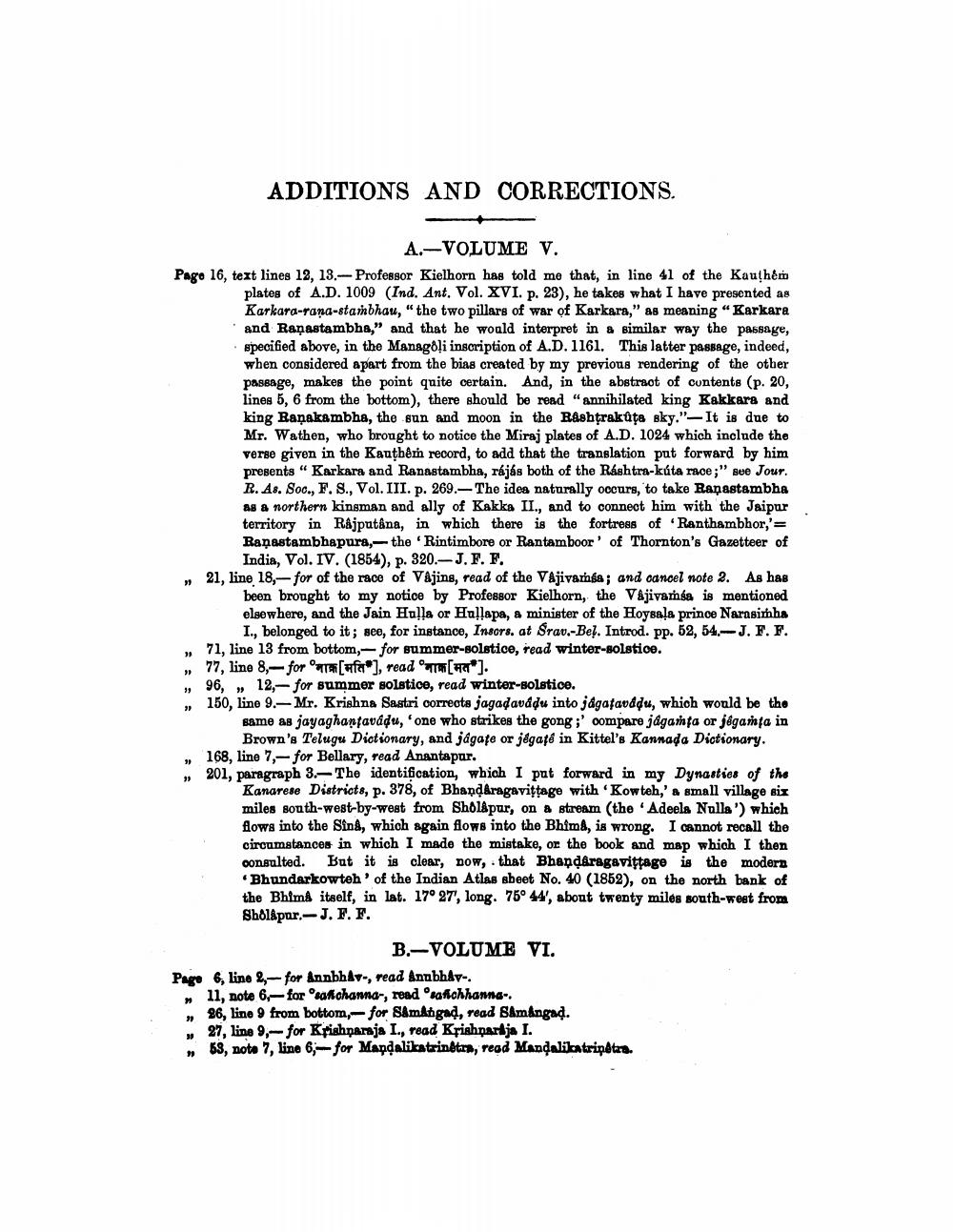________________
ADDITIONS AND CORRECTIONS.
A.-VOLUME V. Pago 16, text lines 12, 13.- Professor Kielhorn has told me that, in line 41 of the Kaushers
plates of A.D. 1009 (Ind. Ant. Vol. XVI. p. 23), he takes what I have presented as Karkara-rana-stambhau," the two pillars of war of Karkara," as meaning "Karkara and Ranastambha," and that he would interpret in a similar way the passage, specified above, in the Managoli inscription of A.D. 1161. This latter passage, indeed, when considered apart from the bias created by my previous rendering of the other passage, makes the point quite certain. And, in the abstract of contents (p. 20, lines 5, 6 from the bottom), there should be read "annihilated king Kakkars and king Raņakambha, the sun and moon in the Rashtrakūta sky."- It is due to Mr. Wathen, who brought to notice the Miraj plates of A.D. 1024 which include the verse given in the Kauthêm record, to add that the translation put forward by him presents " Karkara and Ranastambha, rájás both of the Rashtra-kúta race;" see Jour. R.As. Soc., F. S., Vol. III. p. 269.- The idea naturally occurs, to take Ranastambha as a northern kingman and ally of Kakka II., and to connect him with the Jaipur territory in Rajputâna, in which there is the fortress of Ranthambhor,'= Ranastambhapura,- the 'Rintimbore or Rantamboor' of Thornton's Gazetteer of
India, Vol. IV. (1854), p. 320.-J. F. F. 21, line 18,- for of the race of Vajins, read of the Vajivarsa; and canoel note 2. As has
been brought to my notice by Professor Kielhorn, the Vajivamsa is mentioned elsewhere, and the Jain Hulla or Hallapa, a minister of the Hoysala prince Narasimha
I., belonged to it; see, for instance, Insors. at Srav.-Beļ. Introd. pp. 52, 54.-J. F. F. 71, line 13 from bottom, - for summer-solstice, read winter-solstice. , 77, line 8,- for [#fa®], read [HR].
96, 12,- for summer solstice, read winter-solstice. , 150, lino 9.-Mr. Krishna Sastri correcta jagadavadu into jagatavddu, which would be the
same as jayaghantavadu, 'one who strikes the gong; ' compare jáganta or jéganta in
Brown's Telugu Dictionary, and jagate or jégate in Kittel's Kannada Dictionary. 168, line 7,- for Bellary, read Anantapur. , 201, paragraph 3.-The identification, which I put forward in my Dynasties of the
Kanarese Districts, p. 378, of Bhandaragavittage with 'Kowteh,' a small village six miles south-west-by-west from Sholapur, on a stream (the 'Adeela Nulla') which flows into the Sina, which again flows into the Bhima, is wrong. I cannot recall the circumstances in which I made the mistake, or the book and map which I then consulted. But it is clear, now, that Bhandaragavittage is the modern
Bhundarkowteh' of the Indian Atlas sbeet No. 40 (1852), on the north bank of the Bhima itself, in lat. 17° 27', long. 75° 44', about twenty miles south-west from Sholapar.-J. F. F.
B.-VOLUME VI. Pago 6, lino 2,- for Annbhav-, read Anubhav-.
11, note 6,- for safichanna-, read rafichhanna-. 86, line 9 from bottom, - for Samargad, read Samångad.
27, line 9,- for Krishparaja I., read Krishnardja I. # 63, note 7, line 6;- for Mapdalikatainetun, read Mandalicatriptra.




